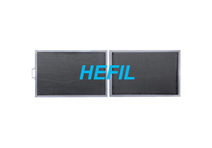HEPA filters, once known as Absolute Filters, were originally developed as the particulate stage of a chemical, biological, radiological (CBR) filtration unit for use by the U.S. Armed Services. However, in modern society, HEPA filter has stepped into common families. It is used as a filtration device to clean air. Do you have any ideas of HEPA filter? This is a brief introduction about HEPA filter structure. HEPA, which is an abbreviation for high efficiency particulate air, is a filtration technology designed during the Manhattan Project to prevent radiation from escaping the labs. Nearly seven decades later, it is still the most sophisticated form of air filtration available. That coupled with its low cost and accessibility makes it the filter medium of choice for hospitals, datacenters, military installations and even residences throughout the world.
HEPA filters are designed based on the size of particles to be removed and the required air flow rate. The HEPA filter structure must be designed as well. The finer the pores in the HEPA material, the finer the particles removed from the air. However, collecting finer particles means the filter material will clog sooner and need replacing on a more frequent basis. The designer will specify the diameter of the glass fibers and the mat density of the filter fabric that fixes the filter pore size.
As to the HEPA filter structure, the glass fibers that make up a HEPA filter are created by passing molten glass or plastic through very fine pores in a spinning nozzle. The resulting glass fibers cool and harden almost instantly because of their tiny diameters. The spinning nozzle moves back and forth (causing the glass fibers to form a web) above a moving conveyor belt onto which the fibers are collected. The speed of the conveyor belt determines the thickness of the filter material—a slow conveyor belt allows more glass fibers to build up on the belt. The melting and cooling of the fiber produces some bonding of the fibers.
As the conveyor progresses, a latex binder is sprayed onto the fabric to provide additional strength. The fabric can be any width up to the practical size of the machinery and can be cut down to the size specified by the customer before the fabric is taken up on rollers. Once the HEPA mats are formed, they are folded into an accordion pattern in an automatic folder. The accordion pattern allows up to 50 ft 2 (5 m 2 ) of filter material to be enclosed in a small space. The accordion-shaped filter is then enclosed in a Gas filter case, usually consisting of an open wire grid. The purpose of the filter case is to support the filter. A true HEPA filter must be able to trap 99.97-percent of all particulate matter that is at least 0.3 microns in diameter. If you are in need of HEPA filters, you can visit www.hefilter.com for more information.





